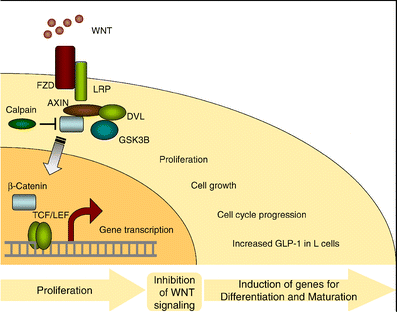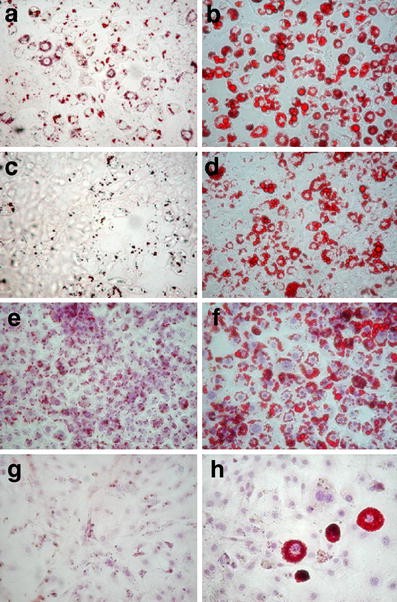TCF7L2 and type 2 diabetes—we WNT to know (original) (raw)
The initial report by Grant et al. [1] that variants in the TCF7L2 gene are strongly associated with risk of developing type 2 diabetes has now been robustly reproduced in many other populations. In fact, variants in this gene contribute more powerfully to the risk of developing type 2 diabetes than any other gene identified to date (see also [[2](/article/10.1007/s00125-006-0521-z#ref-CR2 "Zeggini E, McCarthy MI (2006) TCF7L2: the biggest story in diabetes genetics since HLA? Diabetologia. DOI 10.1007/s00125-006-0507-x
")\]).Since the population-attributable risk is also substantial, we need to understand whether the TCF7L2 variants are causally related to type 2 diabetes, and if so, what the pathogenetic mechanisms are.
The phenotype of individuals carrying the susceptibility variants seems to be slightly at odds with the typical individual at risk, in that the BMI is reduced relative to non-risk variants rather than increased. Virtually all reports have shown impaired insulin secretion following a glucose tolerance test, although the degree of insulin sensitivity has not been stringently defined. Using the minimal model analysis following an IVGTT in non-diabetic at-risk individuals, Damcott et al. [3] found both impaired insulin secretion and reduced insulin sensitivity. Additional studies characterising the phenotype in detail with sensitive techniques will enhance our understanding of the functions of TCF7L2.
Do the TCF7L2 variants have different functions?
The fundamental question of whether the genetic variants have functional consequences has not yet been answered. The identified variants are in the introns rather than in the coding regions. However, this may still lead to functional consequences in terms of protein stability and/or expression of alternatively spliced variants. This lack of information, combined with insufficient in-depth phenotypic characterisations of non-diabetic carriers of the risk variants, makes the pathogenetic mechanisms speculative. However, the well-known fundamental biological action of TCF7L2 and the available information on its role in insulin secretion, adipose tissue development (and, thus, a link to BMI) and insulin sensitivity can provide us with insight into potential mechanisms.
_TCF7L2_—a critical component of WNT signalling and action
TCF7L2, also known as TCF-4, is a nuclear receptor for CTNNB1 (previously known as β-catenin), which in turn mediates the canonical WNT signalling pathway. The WNT signalling pathway is critical for normal embryogenesis, cell proliferation and motility, as well as cell fate determination. Mutations in different molecules involved in WNT signalling have been identified in several cancers, and other disruptive mutations are associated with decreased bone mass [4, 5]. WNT signalling is also critical for the normal self-renewal of stem cells, as well as in regulating myogenesis and adipogenesis [6, 7]. In addition, tightly regulated WNT signalling is required for the normal development of the pancreas and islets during embryonic growth [8].
Figure 1 schematically summarises the canonical (β-catenin-related) WNT signalling pathway. WNTs are ligands secreted by different cells; 19 WNTs have been identified, illustrating the complexity of this signalling pathway, as well as its potential for specificity. WNTs bind to FZD (previously known as Frizzled) and lipoprotein-related protein (LRP) receptors, which, in turn, prevent glycogen synthase kinase 3β (GSK3B) from phosphorylating β-catenin, thereby preventing its degradation and increasing the cellular levels of this activator. In the absence of secreted WNTs, β-catenin is rapidly phosphorylated by GSK3B and degraded. In the presence of WNTs, the increased β-catenin binds to the nuclear receptor TCF7L2, which then leads to its activation and subsequent induction of many different genes and proteins involved in cell proliferation and differentiation. It is obvious, considering the profound effects of WNT signalling, that this pathway needs to be tightly regulated.
Fig. 1
Schematic representation of the canonical WNT signalling pathway, which is fundamental for growth and development. Secreted WNTs bind to FZD and LRP receptors, which, in turn, inactivate the degradation complex consisting of AXIN, DVL and GSK3B. β-Catenin is then not phosphorylated by GSK3B and degraded. Instead, it binds to the nuclear TCF7L2 receptors, thus activating more than 60 different genes involved in regulating growth and differentiation, as well as GLP1 expression and secretion by L-cells and, possibly, also in the brain. Calpain has been shown to promote β-catenin degradation through mechanisms that are at present unclear
Figure 1 also shows the involvement of calpains in regulating the cellular β-catenin levels. Genetic variations in the CAPN10 gene (previously known as calpain 10) have previously been found to be associated with type 2 diabetes [9], but the mechanisms for this are unclear. Calpains are a family of intracellular proteases that are involved in the regulation of the cell cycle and apoptosis. Interestingly, it was recently reported that the calpain system plays an important role in regulating cellular β-catenin levels and, thus, is also involved in the WNT signalling pathway [10].
How is WNT signalling related to type 2 diabetes?
There are several known mechanisms for the involvement of WNT signalling in both insulin secretion and action, as well as in cell differentiation and maturation.
WNT signalling through the TCF7L2 nuclear receptor has been shown to be critical for glucagon-like peptide-1 (GLP-1) secretion by the intestinal endocrine L-cells [11]. Thus, an alteration in this pathway could lead to a reduced secretion of GLP-1 which, in turn, could have consequences for both the insulin secretion following a meal and the generation of new beta cells from the ductal precursor cells. The consensus finding that the TCF7L2 risk variants are associated with a reduced insulin secretion supports such a possibility. This obviously can, and should be, tested through careful phenotyping, with GLP-1 measurements of well-matched non-diabetic individuals carrying or not carrying the risk genotypes. Mice in which the Tcf7l2 gene has been completely ablated die shortly after birth. Interestingly, however, they lack a proliferative compartment in the crypt regions between the villi in the small intestine [12], supporting the possibility of a defect in the development of the GLP-1-secreting L-cells.
However, the recent finding [13] that the TCF7L2 gene is also expressed in human pancreas, in apparent contrast to murine models [11], suggests direct effects on normal beta cell insulin secretion or, more likely, beta cell growth and differentiation from the precursor cells.
How is WNT signalling related to BMI?
WNT signalling plays a fundamental role in regulating adipogenesis and adipose cell differentiation [7]. Unless WNT signalling is inhibited, committed preadipocytes will not differentiate into mature adipose cells. In contrast, loss-of-function mutations in the WNT signalling cascade leads to rapid recruitment and growth of preadipocytes. Recently, an apparent mutation of a WNT protein (WNT10B) was described in a family characterised by severe obesity [14], further linking this pathway to metabolic disorders. Thus, potentially increased WNT signalling in carriers of the TCF7L2 risk variants could be expected to influence adipose tissue growth and development and, thus, BMI.
The fundamental importance of an active WNT signalling on preadipocyte maturation is shown in Fig. 2. When committed preadipocytes are exposed to cytokines such as IL-6 or TNF-α at the early stage of development, i.e. before WNT secretion and signalling is inhibited, these cytokines promote WNT activation to different degrees, thus allowing the development of partially differentiated (IL-6) or completely undifferentiated (TNF-α) cells [15]. In contrast, the cells change their phenotype and become proinflammatory, while the induction of adipokines enhancing insulin sensitivity (e.g. adiponectin) is markedly reduced [15]. It would be very interesting to examine WNT signalling in the adipose tissue of individuals carrying the TCF7L2 variants and also to examine circulating levels of adiponectin, proinflammatory factors and other adipokines.
Fig. 2
Inhibitory effect of preserved WNT signalling on preadipocyte differentiation to adipose cells. 3T3-L1 cells were differentiated without (a, b) or with (c, d) addition of IL-6 for 4 (a, c) or 8 days (b, d). Oil Red O staining shows lipid accumulation. IL-6 induced a partial activation of WNT signalling also leading to a partial differentiation and lipid accumulation of the cells. 3T3-L1 cells differentiated without (e, f) or with TNF-α (g, h) for 4 (e, g) or 8 days (f, h). TNF-α preserved WNT signalling and completely prevented the normal differentiation. (Reproduced from [15], with permission.)
Although the study by Grant et al. [1] provides the most convincing link between the WNT signalling pathway and type 2 diabetes, it is not the only study to make this connection. Kanazawa et al. [16] reported that genetic variants in WNT5B, another gene involved in the non-canonical WNT signalling pathway, were associated with type 2 diabetes in the Japanese population. Interestingly, overexpression of WNT5B in preadipocytes was also found to have a marked effect on the differentiation process [16].
In conclusion, the scientific community has been provided with a new opportunity to understand pathogenetic mechanisms leading to type 2 diabetes. Provided that the TCF7L2 risk variants have important functional consequences, this experiment of nature has taught us that abnormalities in WNT signalling are involved in yet another major human disease. Understanding the mechanisms could provide us with new tools for both the identification and treatment of type 2 diabetes.
References
- Grant SF, Thorleifsson G, Reynisdottir I et al (2006) Variant of transcription factor 7-like 2 (TCF7L2) gene confers risk of type 2 diabetes. Nat Genet 38:320–323
Article PubMed CAS Google Scholar - Zeggini E, McCarthy MI (2006) TCF7L2: the biggest story in diabetes genetics since HLA? Diabetologia. DOI 10.1007/s00125-006-0507-x
- Damcott CM, Pollin TI, Reinhart LJ et al (2006) Polymorphisms in the transcription factor 7-like 2 (TCF7L2) gene are associated with type 2 diabetes in the Amish: replication and evidence for a role in both insulin secretion and insulin resistance. Diabetes 55:2654–2659
Article PubMed CAS Google Scholar - Polakis P (2000) Wnt signaling and cancer. Genes Dev 14:1837–1851
PubMed CAS Google Scholar - Boyden LM, Mao J, Belsky J et al (2002) High bone density due to a mutation in LDL-receptor-related protein 5. N Engl J Med 346:1513–1521
Article PubMed CAS Google Scholar - Etheridge SL, Spencer GJ, Heath DJ, Genever PG (2004) Expression profiling and functional analysis of Wnt signaling mechanisms in mesenchymal stem cells. Stem Cells 22:849–860
Article PubMed CAS Google Scholar - Ross SE, Hemati N, Longo KA et al (2000) Inhibition of adipogenesis by Wnt signaling. Science 289:950–953
Article PubMed CAS Google Scholar - Papadopoulou S, Edlund H (2005) Attenuated Wnt signaling perturbs pancreatic growth but not pancreatic function. Diabetes 54:2844–2851
PubMed CAS Google Scholar - Horikawa Y, Oda N, Cox NJ et al (2000) Genetic variation in the gene encoding calpain-10 is associated with type 2 diabetes mellitus. Nat Genet 26:163–175
Article PubMed CAS Google Scholar - Benetti R, Copetti T, Dell’Orso S et al (2005) The calpain system is involved in the constitutive regulation of beta-catenin signaling functions. J Biol Chem 280:22070–22080
Article PubMed CAS Google Scholar - Yi F, Brubaker PL, Jin T (2005) TCF-4 mediates cell type-specific regulation of proglucagon gene expression by beta-catenin and glycogen synthase kinase-3beta. J Biol Chem 280:1457–1464
Article PubMed CAS Google Scholar - Korinek V, Barker N, Moerer P et al (1998) Depletion of epithelial stem-cell compartments in the small intestine of mice lacking Tcf-4. Nat Genet 19:379–383
Article PubMed CAS Google Scholar - Cauchi S, Meyre D, Dina C et al (2006) Transcription factor TCF7L2 genetic study in the French population: Expression in human β-cells and adipose tissue and strong association with type 2 diabetes. Diabetes 55:2903–2908
Article PubMed CAS Google Scholar - Christodoulides C, Scarda A, Granzotto M et al (2006) WNT10B mutations in human obesity. Diabetologia 49:678–684
Article PubMed CAS Google Scholar - Gustafson B, Smith U (2006) Cytokines promote Wnt signaling and inflammation and impair the normal differentiation and lipid accumulation in 3T3-L1 preadipocytes. J Biol Chem 281:9507–9516
Article PubMed CAS Google Scholar - Kanazawa A, Tsukada S, Sekine A et al (2004) Association of the gene encoding wingless-type mammary tumor virus integration-site family member 5B (WNT5B) with type 2 diabetes. Am J Hum Genet 75:832–843
Article PubMed CAS Google Scholar

